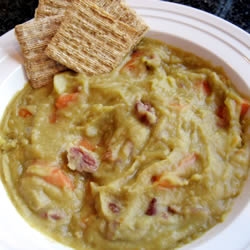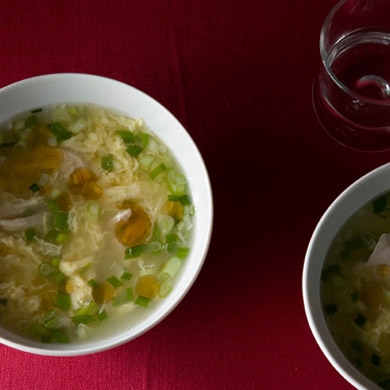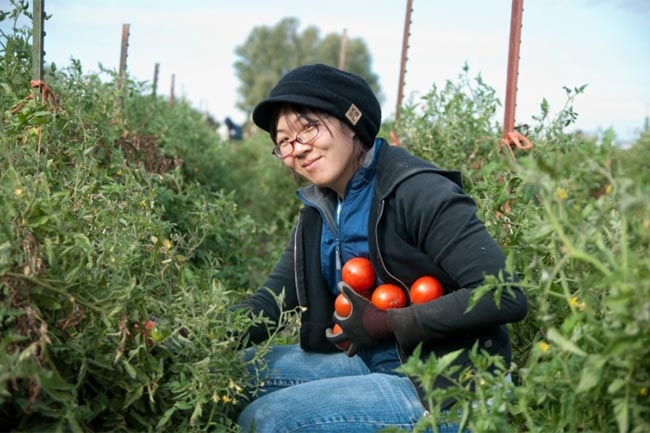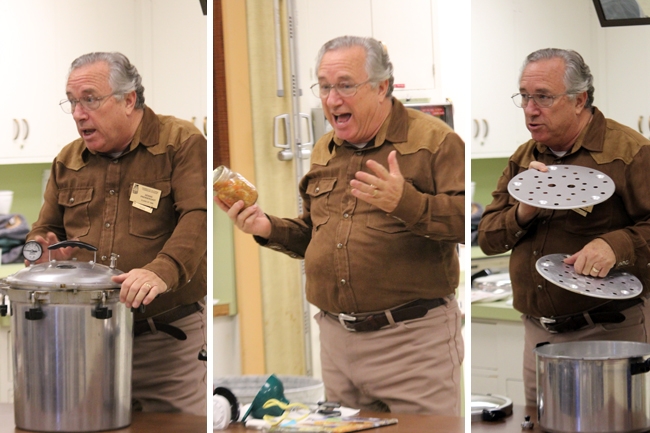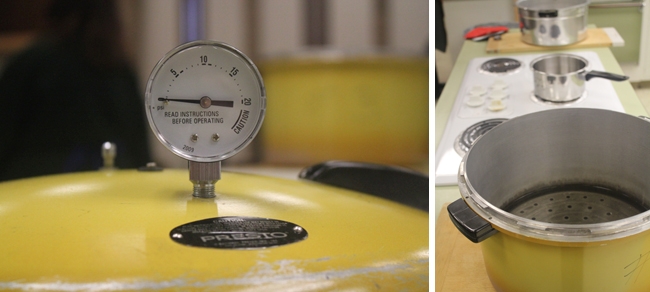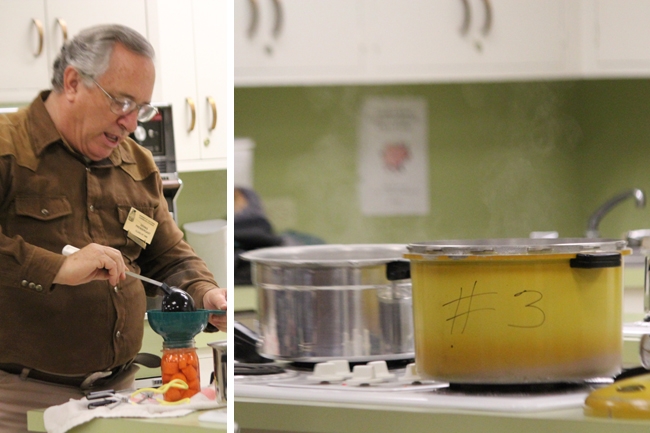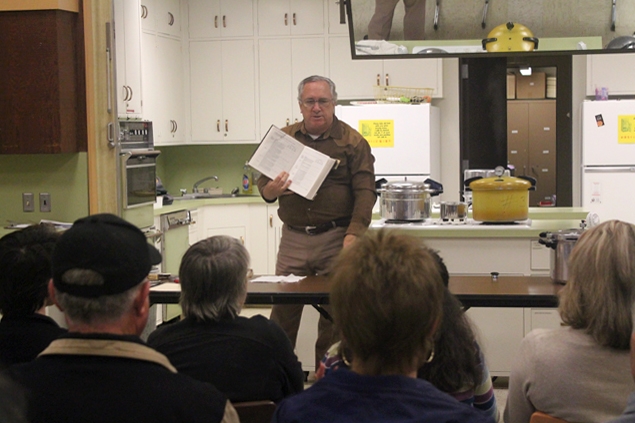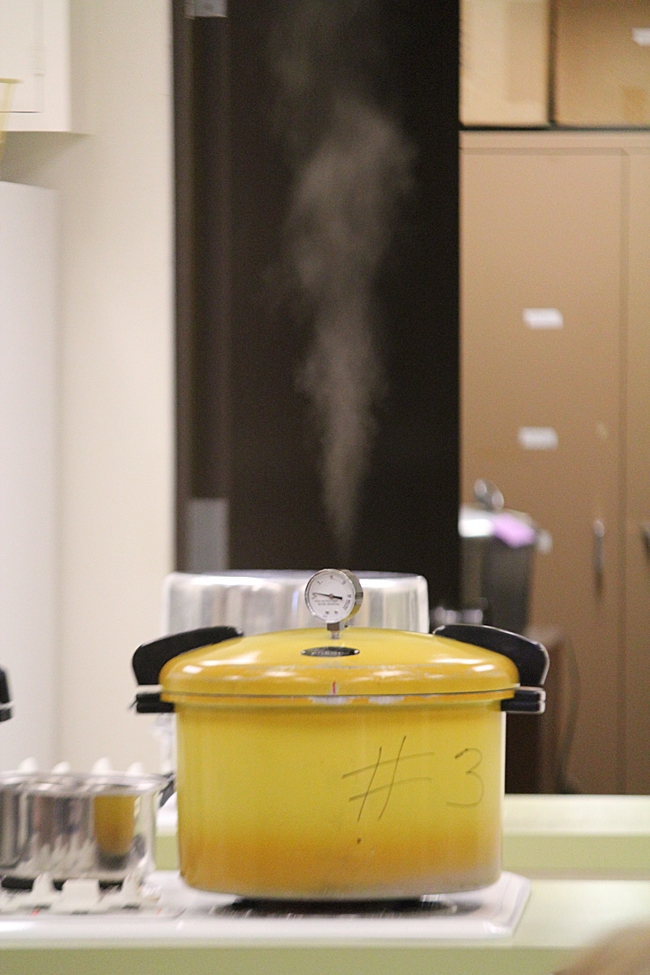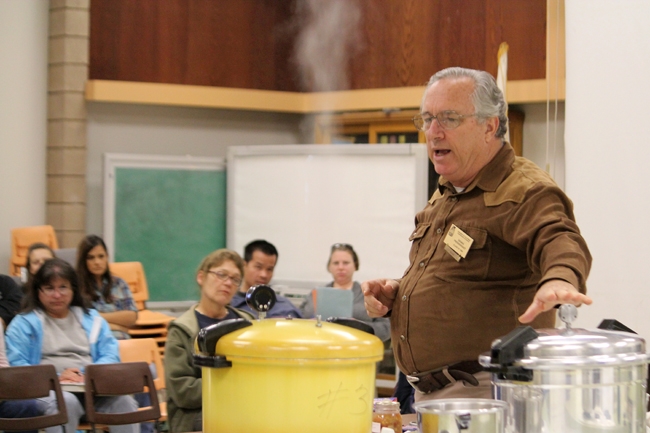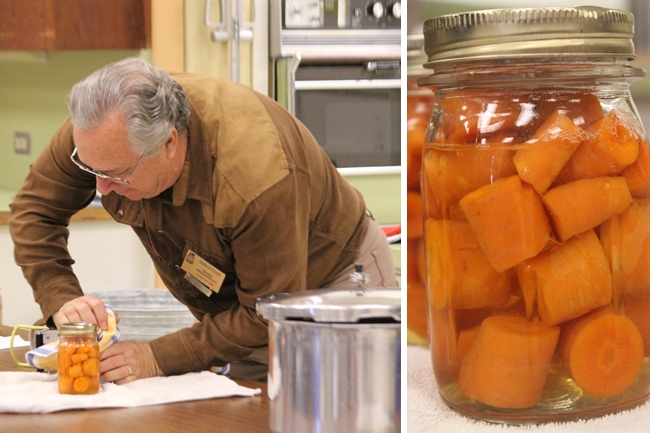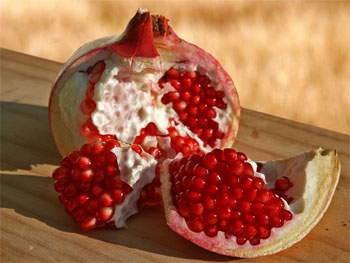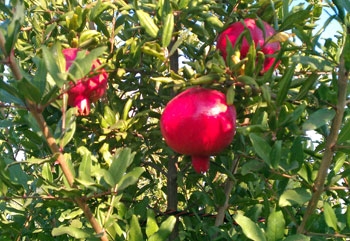UC Food Blog
Time for soup!
She loves to make soup-especially cream of yesterday.—Milton Berle
Suddenly, as I ride my bike to work in the morning, I’m not wearing my capris and sandals, I’m wearing pants, shoes and a jacket—sometimes even gloves! The scarf and ear muffs are not long behind—we have definitely hit fall in northern California!
And fall makes me want to cook comfort food, and what’s more comforting than soup. Not only is soup easy to make, nutritious, delicious, filling and thrifty, you can hide, I mean use, lots of veggies, even some leftovers. Soup is very forgiving. If you add too many ingredients, it just becomes stew!
What’s more elementary than putting a bunch of ingredients in a pot and covering it with some kind of liquid? Nothing, and that’s why soup has been around as long as there was some kind of vessel to make it in. Soup developed regional differences because of what was available where you lived, but it was always a hearty meal and easily digested. Enjoyed across cultures, classes and varying degrees of health, soup remains a classic meal.
Soup is so accessible and inexpensive, it is often used in successful fundraising activities. Across the country “Bowls for Charity” or “Empty Bowl” fundraisers have become popular for, what else, soup kitchens. The concept was initiatied in 1990 when a group of Michigan High School students made ceramic bowls to fill with soup for a food drive. It was so popular, it blossomed into a nationwide fundraiser, focusing on ending hunger. Generally, participants purchase a ticket, choose a handmade bowl, and enjoy a simple meal of soup (often donated by local restaurants), bread and water. The mission of the fundraiser is to remind people that many people have empty bowls, with no food to feed their families. In Yolo County, we have the Empty Bowls luncheon, hosted by the Yolo Wayfarer Center in October; here in Davis we have the annual Souper Bowl in February, hosted by the Davis Co-op, with proceeds going to the Elderly Nutrition Program.
So what’s a good soup to make and share? Well, it could be something thick and hearty like this highly rated Split Pea soup recipe from allrecipes.com:
Split Pea Soup
|
In a large stock pot, cover peas with 2 quarts cold water and soak overnight. If you need a faster method, simmer the peas gently for 2 minutes, and then soak for l hour.
Once peas are soaked, add ham bone, onion, salt, pepper and marjoram. Cover, bring to boil and then simmer for 1 1/2 hours, stirring occasionally.
Remove bone; cut off meat, dice and return meat to soup. Add celery, carrots and potatoes. Cook slowly, uncovered for 30 to 40 minutes or until vegetables are tender.
Or something a little more exotic, but still simple, from epicurious.com, like:
Ginger Scallion Egg-Drop Soup
|
Smash 3 scallions and cut into 2-inch pieces, then put in a 2-quart saucepan with water, broth, ginger, and 3/4 teaspoon salt. Bring to a simmer, and then poach chicken at a bare simmer, uncovered, until just cooked through, 12 to 15 minutes. Transfer chicken to a cutting board and let broth steep, covered, 10 minutes.
Meanwhile, chop remaining 3 scallions and shred chicken.
Discard scallions and ginger from broth and bring to a brisk simmer. Add beaten eggs in a slow stream, stirring constantly. Remove from heat and stir in scallions, chicken, and white pepper (if using). Serve drizzled with sesame oil.
Or one of my favorite quick and healthy go-to weeknight soups:
Fish Stew
- 1 diced onion
- 3 diced white, red or yellow potatoes
- 2 cups chopped celery
- 3 cups water
- 1 pound diced white fish
- ½ lb. shrimp or scallops (or another ½ lb. white fish)
- 2 cups chopped broccoli
- 2 cups chopped cauliflower
- 1 1/2 teaspoons salt
- 1/2 teaspoon ground black pepper
- 1/2 teaspoon crushed dried marjoram
- 1/2 teaspoon crushed dried basil
- 3 tablespoons all-purpose flour
- 2 cups milk (I use skim, and it’s fine, but it would be richer if you used 2% milk)
In a large, deep skillet, boil onion, celery and potatoes in water for 10 minutes. Add flounder, broccoli, cauliflower, salt, pepper, marjoram and basil.
In a separate bowl, mix flour with milk and slowly add to soup mixture while stirring continuously. Reduce heat and simmer for about 15 minutes. Add shrimp and/or scallops; cook 3-5 minutes more.
UC student farms seed innovation
Back in the 1960s and 1970s, when organic was a foreign word to most Americans, students at UC Davis and UC Santa Cruz were part of a wave of environmental activism that sought alternatives to agricultural methods that distanced people from farms and relied on heavy use of chemical pesticides and fertilizers.
In 1971, student enthusiasm for a garden at UC Santa Cruz that used natural cultivation methods grew so much so that 14 acres were set aside for the UC Santa Cruz Farm and Garden to create more opportunities to research and teach organic farming. Meanwhile, a student-led seminar at UC Davis on alternative agriculture mushroomed into a group that lobbied campus administration for land to create a farm that would explore sustainable agriculture. With support from the College of Agricultural and Environmental Science, the UC Davis Student Farm formed in 1977 on 20 acres of what was then a remote corner of campus.
In the decades that followed, these student-led movements helped spur the growth of organic farming and formed the foundations for innovative sustainable agriculture research and education programs at UC Davis and UC Santa Cruz that have served as models for other universities.
Read more and view slideshow at UC Newsroom
Peek inside a UC Master Food Preserver kitchen
I brought my camera with me to a Master Food Preservers class Saturday at UC Cooperative Extension Sacramento County on pressure canning. In case you’ve been thinking about participating in a Master Food Preservers class, here’s a peek inside the Sacramento demonstration kitchen:
“Cooking is a whole different ball game from canning — a whole different science,” Prendergast said. He's been a UC Master Food Preserver since 1995, and regularly teaches the monthly Saturday morning classes in Sacramento county. Next month's Saturday morning class will be on dehydrating, 10 a.m. to 12 p.m., Dec. 10.
UC Master Food Preservers is a volunteer organization structured in a way similar to UC Master Gardeners. Master Food Preserver candidates complete training to become knowledgeable in food preservation and then are required to volunteer time sharing their knowledge with the public by teaching classes and answering questions.
UC Cooperative Extension currently has Master Food Preservers in four counties:
- Sacramento
- El Dorado (now known as Central Sierra)
- Los Angeles
- San Bernardino
In Sacramento County, the Master Food Preservers offer a monthly class on Saturday mornings that focuses on techniques of a specific preservation process – either water-bath canning, pressure canning or dehydrating. Once a month on Wednesday evenings, the group offers classes that focus on preserving specific fruits or vegetables.
This Wednesday’s class is on “Fall Fruits and Winter Squash” which will include quince and pomegranates among others. The class is 6:30 – 8:30 p.m. at the UC Cooperative Extension office, 4145 Branch Center Road in Sacramento; registration to attend is $3.
Time for a new citrus variety in your backyard?
To me, one of the best things about fall and winter in California is that these seasons herald the beginning of citrus season. Each November, I anxiously await the arrival of the Satsuma Mandarins at the farmer's market, and during their short but delicious season we indulge in a 10-pound bag of the little gems every week.
We have three kinds of citrus growing in our backyard, (sadly no Satsumas), and I secretly enjoy calling family back in Colorado when I know it's snowing to report that we are enjoying juice squeezed from oranges picked from our tree that morning.
If you enjoy growing your own citrus (even without the guilty pleasure of tormenting your relatives) you'll want to check out the new UCANR publication Tried and True or Something New? Selected Citrus Varieties for the Home Gardener. This free, downloadable publication gives side-by-side comparisons of old backyard favorites to newly developed varieties suitable for home growers.
The guide includes ripening information for Riverside, but gardeners in subtropical climate zones statewide can enjoy success with most of these varieties.
From blood oranges to citrons, kumquats to 'Kaffir' limes, there's something different here for every gardener. Hmmmm, I think I need to find a place in our yard for a "Tahoe Gold!"
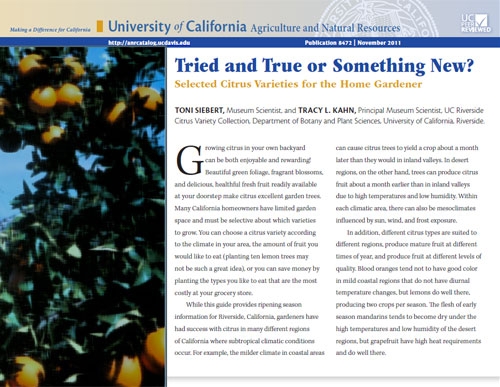
TriedandTrue
The colorful, healthful pomegranate is a good food and lovely landscape plant
A jewel-toned garnish for California cuisine, antioxidant-rich elixir of good health, drought-resistant tree ideal for desert-like regions in California, the pomegranate has inner beauty and outward resiliency driving its growing popularity.
Pomegranates have been cultivated since ancient times, and are referred to poetically in texts ranging from the Bible to Shakespeare’s Romeo and Juliet. They are unusual among California fruit. Tough, leathery skin protects bright red, tart-sweet juice sacs, called arils, which are separated in groups by white spongy tissue. Inside each sac is an edible seed which contains fiber and unsaturated fat. The red pulp is a good source of potassium and vitamin C.
More a large shrub than a tree, with multiple trunks reaching a height of 15 to 20 feet, pomegranates are adapted to regions with cool winters and hot summers. Beautiful shiny foliage and a long flowering season make them attractive additions to coastal, inland valley and desert landscapes. Pomegranates tolerate a wide range of soil types, but prefer deep, well-drained loams. The best time to plant is in late winter or early spring – just before they leaf out.
Data about the scope of California commercial pomegranate production is hard to find. USDA stopped collecting pomegranate data in 1989 and CDFA groups pomegranates with kumquats, loquats, persimmons, prickly pears and other unusual fruit. UC Cooperative Extension farm advisor Maxwell Norton said county pesticide registration data indicate that five Central Valley counties – Kern, Fresno, Madera, Kings and Tulare – have about 35,000 acres planted to pomegranate. About 500 acres are planted in other counties combined. Kern County has the highest production with about 17,000 acres producing fruit valued at $115 million per year.
UC Cooperative Extension farm advisor Paul Vossen suggests the following standard varieties for backyard plantings:
- Ambrosia – Huge fruit, pale pink skin, similar to Wonderful
- Eversweet – Very sweet. Red skin, clear juice. Good for coastal areas
- Granada – Deep crimson fruit color. Matures early, but needs heat
- Ruby Red – Matures late, but not as sweet or colorful as Wonderful.
- Wonderful – Large, deep red fruit, large, juice red kernels. Small seeds.
For eating or juicing, select pomegranates at grocery stores by weight, not color. The heavier the pomegranate, the more juice inside. Some consumers are deterred from purchasing and eating the raw fruit because they believe it’s difficult to prepare. UC Master Food Preserver Geri Scalzi gives five simple steps that make eating fresh pomegranate easy:
- Cut off the top half an inch below the crown. Four to six sections of pomegranate arils divided by white membrane will be visible.
- Score the leathery skin with a sharp knife along each section.
- Break the pomegranate apart along the score lines. This can be done under water to prevent squirting pomegranate juice, which tends to stain clothing.
- Loosen arils and membranes and drop them into water. The arils will sink, the membranes will float. Skim off the membranes with a slotted spoon.
- Pour the arils and remaining liquid through a strainer.
The pulpy seed sacs are then ready to be eaten plain, tossed in salads, stirred into yogurt or sprinkled over cereal.
For more information on pomegranate production, attend a public meeting at the UC Kearney Agricultural Research and Extension Center, 9240 S. Riverbend Ave., Parlier, from 10 a.m to 1 p.m. Tuesday, Nov. 29. The following topics will be covered:
- Insect pest update, integrated pest management entomologist Walt Bentley
- Black heart disorder and tree decline issues, UC Davis plant pathologist Themis Michailides
- Interesting selections in the USDA germplasm collection, USDA national clonal germplasm representative Jeff Moersfelder
- Irrigation, fertigation & nitrogen use efficiency with drip irrigation, Claude J. Phené, USDA-ARS
- Summary of acreage trends, Merced County farm advisor Maxwell Norton
RSVP to Yolanda Murillo at ymurillo@ucdavis.edu or (559) 600-7285. The $10 registration fee may be paid at the door with cash or check. More information.


